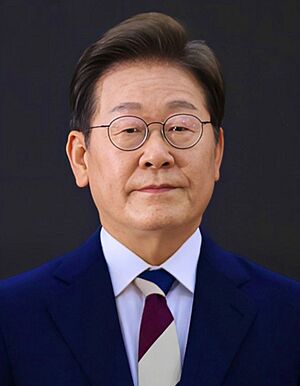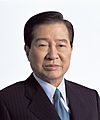President of South Korea facts for kids
Quick facts for kids President of the Republic of Korea |
|
|---|---|

Presidential standard
|
|
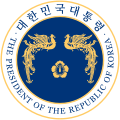
Presidential seal
|
|
| Executive branch of the Government of South Korea Office of the President |
|
| Style |
|
| Member of |
|
| Residence | Presidential Residence of South Korea |
| Seat | Seoul |
| Appointer | Direct popular vote |
| Term length | Five years,
Non renewable
|
| Constituting instrument | Constitution of South Korea (1948) |
| Precursor | President of the Provisional Government of the Republic of Korea |
| Formation | 24 July 1948 |
| First holder | Syngman Rhee |
| Deputy | Prime Minister of South Korea |
| Salary | ₩240,648,000/USD$ 165,084 annually (2024) |
The President of the Republic of Korea (Korean: 대한민국 대통령), also known as the President of South Korea, is the country's top leader. This person acts as both the head of state (representing the country) and the head of government (leading the government). The president also leads the military as its commander-in-chief.
The president is chosen by the people in a direct election. They serve for a single five-year term and cannot be re-elected. If the president's position becomes empty, a new election must happen within 60 days. During this time, the prime minister or another senior official takes over the president's duties.
Lee Jae Myung became the President of South Korea on June 4, 2025. He is a member of the Democratic Party.
Contents
- History of the Presidency
- What the President Does
- How Long a President Can Serve
- How the President is Elected
- Groups That Help the President
- Removing a President from Office
- Presidential Office and Residence
- President's Pay and Benefits
- After Being President
- Who Takes Over if the President Can't Serve?
- Timeline of Presidents
- Images for kids
- See also
History of the Presidency
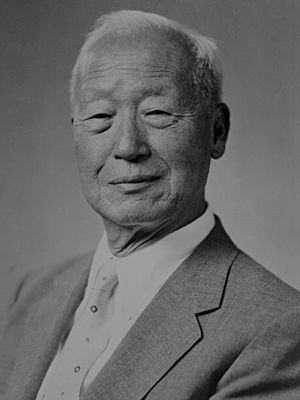
Before South Korea was officially formed in 1948, there was a group called the Provisional Government of the Republic of Korea. This group was set up in 1919 to fight against Japanese rule. South Korea's current laws recognize this group as an important part of its history.
The length of a president's term has changed over time.
- From 1948 to 1972, a term was four years.
- From 1972 to 1981, it was six years.
- From 1981 to 1988, it was seven years.
Since 1981, presidents have only been allowed to serve one term. In 1988, the term was set to five years, which it remains today.
What the President Does
The Constitution of South Korea explains the president's main jobs and powers.
President's Main Duties
The president must:
- Protect the Constitution, which is the country's main law.
- Keep South Korea safe and secure.
- Work towards a peaceful reunion of North and South Korea. The president often leads the Peaceful Unification Advisory Council.
President's Powers
The president has the power to:
- Lead the executive branch of the government.
- Command the South Korean military.
- Declare war.
- Ask the public to vote on important national issues through a referendum.
- Issue executive orders (special rules).
- Give out medals to honor people who have served the nation.
- Grant pardons (forgive people for crimes).
- Declare a state of emergency in times of crisis.
- Veto bills (reject laws) passed by the National Assembly. However, the National Assembly can still pass the law if two-thirds of its members vote for it again.
If the National Assembly disagrees with a presidential decision, they can vote against it. If they do, the president's decision is immediately canceled.
The president can also take emergency actions during serious problems like national threats or economic crises. These actions can only happen when the National Assembly is not meeting and there's no time to call them together. Any emergency actions must be approved by the National Assembly later. If the Assembly doesn't approve, the actions are stopped.
How Long a President Can Serve
The president can only serve one five-year term. This rule was put in place in 1987 to prevent leaders from staying in power for too long. Even if the laws about term limits change, they won't apply to the president who is currently in office.
How the President is Elected
The rules for electing the president are in the South Korean Constitution and the Public Official Election Act. The president is chosen by a direct vote from the people. The person who gets the most votes wins.
Recent Election Results
2025 South Korean presidential election
Groups That Help the President
The president gets help from many groups and people. The Presidential Secretariat is a key group, led by a secretary general.
Other important groups include:
- The National Security Council: This group advises the president on matters related to national security, like foreign policy and military issues.
- The Peaceful Unification Advisory Council: This group helps with ideas for reuniting Korea.
- The Audit and Inspection Board: This board checks the financial records of government groups and how well public officials are doing their jobs. They report their findings to the president and the National Assembly.
Removing a President from Office
A president can be removed from office through a process called impeachment. This happens if the president breaks the Constitution or other laws while doing their job.
Here's how impeachment works:
- A proposal to impeach the president must be supported by a majority of members in the National Assembly.
- Then, at least two-thirds of the total members of the National Assembly must vote to approve the impeachment. This means 200 out of 300 members must agree.
- If the National Assembly votes for impeachment, the president is immediately stopped from doing their job.
- The Constitutional Court then makes the final decision. They have 180 days to decide if the president should be removed. If the president leaves office before the court makes a decision, the case is closed.
Three presidents have faced impeachment since 1948:
- Roh Moo-hyun was impeached in 2004, but the Constitutional Court overturned it, meaning he stayed in office.
- Park Geun-hye was impeached in 2016, and the Constitutional Court confirmed it in 2017, removing her from office.
- Yoon Suk Yeol was impeached in 2024, and the Constitutional Court confirmed it in 2025, removing him from office.
- Han Duck-soo became the first acting president to be impeached in 2024.
Presidential Office and Residence
The traditional presidential office and residence was called the Cheong Wa Dae (Korean: 청와대; Hanja: 靑瓦臺). It was a large complex of buildings built in a traditional Korean style. It covered about 250,000 square meters (62 acres).
In May 2022, when President Yoon Suk Yeol took office, the Cheong Wa Dae was opened to the public as a park. The president's office and residence moved to the former Ministry of National Defense building in the Yongsan District of Seoul. This new location is now the Office of the President of South Korea.
President's Pay and Benefits
As of 2021, the president earns about ₩240,648,000 (around USD$165,084) each year. They also have an expense account for travel and other needs while in office.
The president also has access to other government offices and residences, especially in major cities, for when they travel.

For ground travel, the president uses a special Hyundai Nexo SUV. For air travel, they use a modified Boeing 747-8 plane, known as Code One, and a modified Sikorsky S-92 helicopter.
After Being President
All former presidents receive a pension for life and security protection from the Presidential Security Service. Unlike other officials, a former president cannot refuse this security.
However, presidents who are impeached lose many of their post-presidency benefits. This includes their pension, free medical care, money for their offices, and the right to be buried at the Seoul National Cemetery. They still keep their security protection.
Who Takes Over if the President Can't Serve?
If the president cannot do their job, the prime minister takes over as acting president. If the prime minister also cannot serve, other cabinet members follow in a specific order. If the presidency becomes permanently empty, the acting president must hold new elections within 60 days.
Timeline of Presidents
| Ideology | # | Time in office | Name(s) | |
|---|---|---|---|---|
| Conservative | 9 | 21765 days | Choi Kyu-hah, Chun Doo-hwan, Kim Young-sam, Lee Myung-bak, Park Chung Hee, Park Geun-hye, Roh Tae-woo, Syngman Rhee, and Yoon Suk Yeol | |
| Liberal | 5 | 6273 days | Kim Dae-jung, Lee Jae Myung (incumbent), Moon Jae-in, Roh Moo-hyun, and Yun Po-sun | |
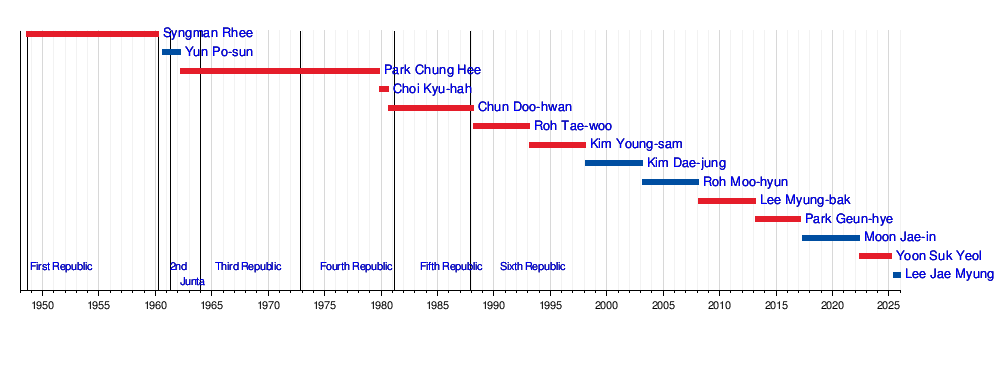
Images for kids
-
1st: Syngman Rhee
1st, 2nd & 3rd terms
(served: 1948–1960) -
3rd: Park Chung Hee
5th, 6th, 7th, 8th & 9th terms
(served: 1963–1979) -
4th: Choi Kyu-hah
10th term
(served: 1979–1980) -
5th: Chun Doo-hwan
11th & 12th terms
(served: 1980–1988) -
6th: Roh Tae-woo
13th term
(served: 1988–1993) -
7th: Kim Young-sam
14th term
(served: 1993–1998) -
8th: Kim Dae-jung
15th term
(served: 1998–2003) -
9th: Roh Moo-hyun
16th term
(served: 2003–2008) -
10th: Lee Myung-bak
17th term
(served: 2008–2013) -
11th: Park Geun-hye
18th term
(served: 2013–2017) -
12th: Moon Jae-in
19th term
(served: 2017–2022) -
13th: Yoon Suk Yeol
20th term
(served: 2022–2025) -
14th: Lee Jae Myung
21st term
(serving: 2025–present)
See also
 In Spanish: Anexo:Presidentes de Corea del Sur para niños
In Spanish: Anexo:Presidentes de Corea del Sur para niños
- First Lady of South Korea
- List of presidents of South Korea
- Presidential elections in South Korea
- Transportation of the president of South Korea


